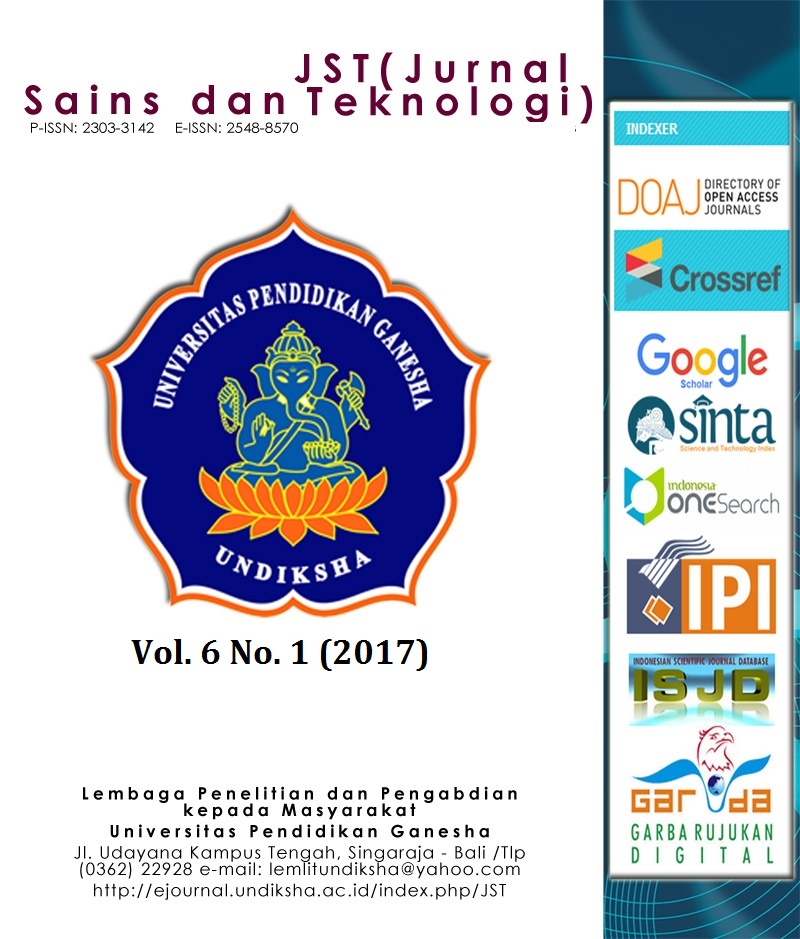RANCANG BANGUN PROTOTYPE SISTEM KENDALI LENGAN ROBOT PEMINDAH BARANG MENGGUNAKAN INTERFACE WIRELESS 2.4Ghz
DOI:
https://doi.org/10.23887/jstundiksha.v6i1.9185Keywords:
Arm Robot, Mikrokontroler, Wireless JoystikAbstract
Perkembangan teknologi yang semakin maju, terutama dalam bidang sistem kendali, Sistem kendali lengan robot merupakan robot yang bisa menggantikan peran manusia seperti melakukan perkerjaan berat. Lengan robot yang dirancang dalam bentuk prototipe dengan sistem kerjanya yang dapat dikendalikan menggunakan wireless joystick, sehingga robot dapat memindahkan objek dan dikendalikan dari jarak jauh. Perancangan sistem kendali ini menggunakan beberapa komponen yaitu Mikrokontroler ATmega 8 Motor Servo, Driver Motor, Weireless Joystik PS2, dan Baterai. Hasil yang diperoleh dari penelitian ini adalah rancangan bangun sistem kendali lengan robot pemindah barang mengunakan interface wireless 2.4Ghz. Hasilnya robot dapat dikendalikan dan merespon perintah yang diberikan melalui joystikReferences
Kanuka, H., Smith, E. E., & Kelland, J. H. (2013). An Inquiry into Educational Technologists’ Conceptions of Their Philosophies of Teaching and Technology. Canadian Journal of Learning and Technology, 39(2), 1–27.
Makki, B., & Makki, B. (2012). The Impact of Integration of Instructional Systems Technology into Research and Educational Technology, 3(2), 275–280. https://doi.org/10.4236/ce.2012.32043
Martin, W., Strother, S., Beglau, M., Bates, L., Reitzes, T., & Culp, K. M. M. (2010). Connecting instructional technology professional development to teacher and student outcomes. Journal of Research on Technology in Education, 43(1), 53–74. https://doi.org/10.1080/15391523.2010.10782561
Reeves, T. C., & Ph, D. (1998). The Impact of Media and Technology in Schools. A Research Report Prepared for the Bertelsmann Foundation University of Georgia Partnership for 21st Century Skills 2003 Learning for the 21st Century A Report and a Mile Guide for 21st Century Skills Washington, 49 p. Retrieved from http://it.coe.uga.edu/~ treeves/edit6900/BertelsmannReeves98.pdf
Roslinda Alias, Nor Aziah Alias, Abu Bakar Ibrahim, & Jamizan Jalaluddin. (2013). Proposed Technology Solutions for Special Educational Needs (SEN) Learners: Towards Inclusive Education in Malaysian Universities. International Journal of Information and Education Technology, 3(2), 206–210. https://doi.org/10.7763/IJIET.2013.V3.265
Smaldino, S. E., Lowther, D. L., & Russell, J. D. (2008). Instructional technology and media for learning. Jakarta: Kencana Perdana Media Group.
Venkatesh, V. (2012). CONSUMER A CCEPTANCE AND USE OF I NFORMATION TECHNOLOGY : E XTENDING THE UNIFIED T HEORY, 36(1), 157–178.
Downloads
Published
How to Cite
Issue
Section
License
Authors who publish with the Jurnal Sains dan Teknologi (JST) agree to the following terms:
- Authors retain copyright and grant the journal the right of first publication with the work simultaneously licensed under a Creative Commons Attribution License (CC BY-SA 4.0) that allows others to share the work with an acknowledgment of the work's authorship and initial publication in this journal.
- Authors are able to enter into separate, additional contractual arrangements for the non-exclusive distribution of the journal's published version of the work (e.g., post it to an institutional repository or publish it in a book), with an acknowledgment of its initial publication in this journal.
- Authors are permitted and encouraged to post their work online (e.g., in institutional repositories or on their website) prior to and during the submission process, as it can lead to productive exchanges, as well as earlier and greater citation of published work. (See The Effect of Open Access)
















